| < Prev | Next > |
|---|
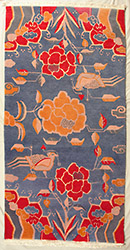 The traditional Tibetan rug knows a large variety of design patterns and symbols.
The traditional Tibetan rug knows a large variety of design patterns and symbols.
Quite different from Tibetan thangka painting with rather strict iconographic design patterns and rules, the designers and weavers of Tibetan carpets have a rather large degree of freedom in combining patterns, symbols and colors.
Typical Designs of Tibetan Rugs
Thus a good, individual Tibetan carpet made after old traditional designs is always a unique, individual piece and the product of the skill and experience of the weaver and designer.
Medallions
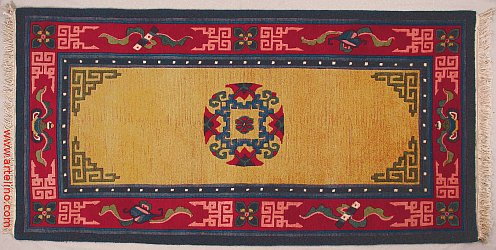
This design can be found with single, two, three and sometimes more medallions in the middle or in a geometric pattern over the complete rug. Typically the medallions come with a Tibetan border pattern. Some of the medallions symbolize coins. Others may have floral shapes or form roundels of phoenix birds, cranes or a dragon or have the Chinese symbol for longevity in the center.
Other types of roundels look like Buddhist mandalas. Scholars think that the three medallions pattern has its roots in Buddhist art showing Buddha flanked by two attendants. There are lots of disputed theories among Western scholars regarding Tibetan rugs. One of these theories, now given up, was that the Tibetan rug is not older than early 19th century. This theory was a thing of the past when Tibetans referred to scripts older than a thousand years in which rugs were mentioned. I personally rely more on what the Tibetan people who make rugs, are telling or what Tibetan experts like Kesang Tashi write.
Dragons
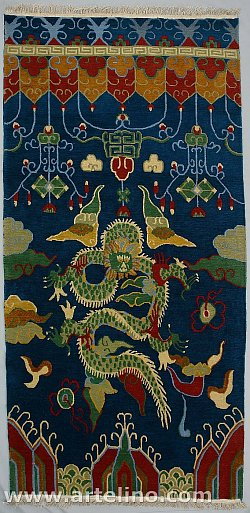 The dragon design is maybe the one that is associated most with a traditional Tibetan pattern. Don't be afraid of taking such a "monster" into your home. The Tibetan dragons are benevolent beings and bring power, wisdom and good luck to their owners. It is interesting to take a closer look on the dragons' faces on Tibetan rugs. They look all so different - some funny, some with a friendly smile, some like trying to look fearful and some remind me of cartoons and others may look so cute.
The dragon design is maybe the one that is associated most with a traditional Tibetan pattern. Don't be afraid of taking such a "monster" into your home. The Tibetan dragons are benevolent beings and bring power, wisdom and good luck to their owners. It is interesting to take a closer look on the dragons' faces on Tibetan rugs. They look all so different - some funny, some with a friendly smile, some like trying to look fearful and some remind me of cartoons and others may look so cute.
Dragons on traditional Tibetan carpet designs are often shown with the Buddhist jewel in one claw. Then they usually fly through the air, an image that the designers enhance by showing stylized cloud patterns.
Hallvard Kare Kuloy describes the dragon in his book "Tibetan Rugs" as the life-giving feature composed of other animals:
- Horn like stag.
- Forehead like a camel.
- Eyes like a demon.
- Neck like a snake.
- Belly like a sea monster.
- Scales like a carp.
- Claws like an eagle.
- Paws like the tiger.
- Ears like an ox.
Floral Designs
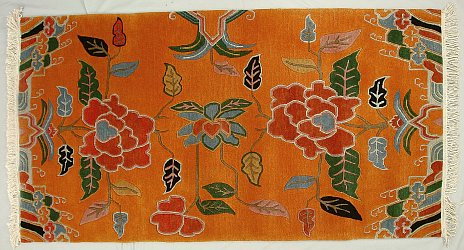
Some of the floral rug designs show the influence of Chinese textile patterns.
Phoenix
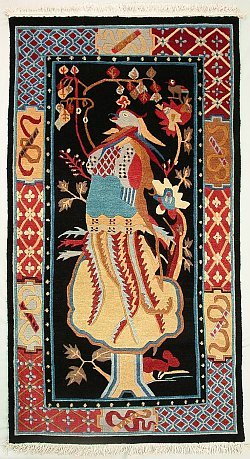 The phoenix bird is shown alone or in combination with dragons. Phoenix and dragons are like counterparts - emperor and empress, yin and yang.
The phoenix bird is shown alone or in combination with dragons. Phoenix and dragons are like counterparts - emperor and empress, yin and yang.
The majestic phoenix shown in the above design fills nearly the complete carpet size inside the border. This is a rather rare design.
In analogy to the explanation of the dragon, the phoenix is seen as another creature composed of features of other animals. The author Hallvard Kare Kuroy lists these as follows:
- Front of a wild swan.
- Backside of the unicorn.
- Throat of the swallow.
- Bill of a fowl.
- Neck of a snake.
- Tail of a fish.
- Forehead of a crane.
- Crown of a mandarin drake.
- Strips of a dragon.
- Vaulted back of a tortoise.
Snow Lions
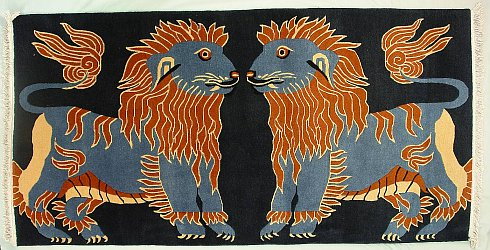
The snow lion is not a real animal existing in nature but a Tibetan mythological being. Since 1909 it has been a part of the Tibetan flag and a symbol for Tibetan identity. Please see our article about the Tibetan snow lion.
Tiger Rugs
Tigers are a symbol of power and strength. They are seen as the animal from the south. They are frequently shown strolling in a bamboo forest. A different subject for tiger rugs are flayed tiger skins like the example on this page.
One assumes that tiger rugs were a privilege of high lamas and of the aristocracy. On old photos one can see Tibetan dignitaries sitting on a tiger rug or in front of one that is attached behind them as wall decoration.
Door Carpets
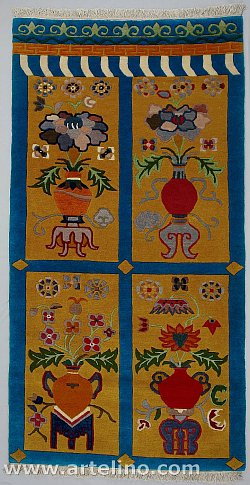 Door curtains have become a rare design. The designs are not in demand by Western buyers although they are beautiful. The designs have the same basic patterns as the carpet shown above. It was made after door and window curtains. In a harsh and windy climate like on the Tibetan plateau such carpets were used as door curtains.
Door curtains have become a rare design. The designs are not in demand by Western buyers although they are beautiful. The designs have the same basic patterns as the carpet shown above. It was made after door and window curtains. In a harsh and windy climate like on the Tibetan plateau such carpets were used as door curtains.
Due to the artistic quality and its beauty, some people do not use the Tibetan rugs exclusively on the floor, but hang them on walls like a painting. Door carpets are ideal for this usage.
Geometric and Abstract Designs
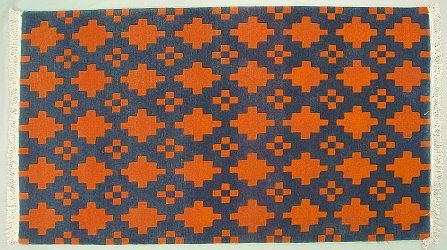
These designs look like modern creations made after the designs of Western interior decorators and for the taste of Western buyers. But they are actually traditional designs like the above rug.
The tradition of these simple geometric and abstract patterns comes from the typical "village-made" Tibetan rug made by nomads for their own use. These carpets were simple in design and miss the sophistication of the rugs made in special carpet workshops as they were operated in Gyantse or Shigatse or Lhasa.
A special form among geometric patterns is the check board design of Tibetan rugs.
Dieter Wanczura
(January 2009)







